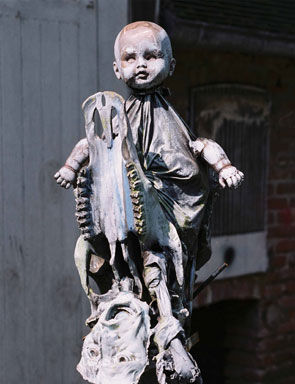'Dado: The Zorzi Elegies' in Montenegro Pavilion @ Palazzo Zorzi
"B. Réquichot", painted compressed iron and bronze, 185 x 60 x 45 cm (détail). Photo: Domingo Djuric.
VENICE.- For half a century, the well-known Montenegrin-born artist Dado (b. Cetinje, 1933) has been creating a world of delicate horror and intricate fantasy in every medium from painting and fresco to drawing, engraving and book illustration.
In 1989, the mill at Hérouval in Normandy, France that has long been Dado’s adoptive home burnt down. Among the many things consumed by the fire was a series of sculptures that Dado had begun to work on. These sculptures marked both a new departure for the artist and a summum of what he had created before. Where he had relied until then on his prodigious graphic ability and unerring eye for acidic colour to create a world of sinuously suggestive horror (unequalled since Bosch), here he was confronted by new demands on his extraordinary plastic inventiveness.
Burrowing into the smoking ruins of his studio, Dado dragged out and salvaged the elements destined to constitute a new race of sculptures. He has since baptized them the ‘Zorzi Elegies’ in honour of the splendid Renaissance palazzo where his works are exhibited during the Venice Biennale. Cast in bronze, the sculptures juxtapose the most unlikely and arresting elements: a saint’s head with a tree trunk and a half-melted saucepan, for instance, or a homunculus in a bucket welded to an ancient washing machine drenched in bright colour.
Around the elegant Palazzo Zorzi courtyard, where a score of these eloquent artefacts subtly blending the sacred and the profane are displayed, stand several vast banners based on photographs recording the fire on which the artist has superimposed images that came to him as, after a misdiagnosed illness, he hung between life and death recently in a six-day coma.
Each of the sculptures exhibited has been dedicated to a number of people, poets, painters and friends all now dead, that have been of central importance to Dado and his career as an artist. Grouped together with a number of Dado’s paintings on wood lent by the National Museum of Montenegro, the ensemble makes an unusually powerful impact, setting up a direct and eloquent dialogue with the dead that brings sharply into question our own identities and bearings in existence.
The commissioner for the exhibition is Michael Peppiatt, formerly editor of ‘Art International’ and best known for his books and exhibitions on Francis Bacon, Alberto Giacometti and other major 20th-century artists.
Dado in his studio, May 2009. Photo: Domingo Djuric.

/https%3A%2F%2Fprofilepics.canalblog.com%2Fprofilepics%2F1%2F0%2F100183.jpg)
/https%3A%2F%2Fstorage.canalblog.com%2F03%2F02%2F119589%2F96711876_o.jpg)
/https%3A%2F%2Fstorage.canalblog.com%2F11%2F31%2F119589%2F94773502_o.jpg)
/https%3A%2F%2Fstorage.canalblog.com%2F20%2F83%2F119589%2F94772815_o.jpg)
/https%3A%2F%2Fstorage.canalblog.com%2F26%2F72%2F119589%2F75604929_o.jpg)
/https%3A%2F%2Fstorage.canalblog.com%2F59%2F60%2F119589%2F26458628_o.jpg)




/http%3A%2F%2Fstorage.canalblog.com%2F07%2F29%2F119589%2F129522610_o.jpg)
/http%3A%2F%2Fstorage.canalblog.com%2F89%2F83%2F119589%2F126948054_o.jpg)
/http%3A%2F%2Fstorage.canalblog.com%2F43%2F07%2F119589%2F126939546_o.jpg)
/http%3A%2F%2Fstorage.canalblog.com%2F96%2F67%2F119589%2F122169248_o.jpg)